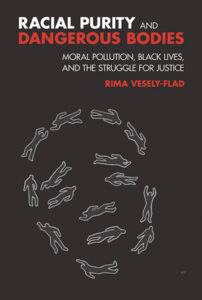Racial Purity and Dangerous Bodies: Moral Pollution, Black Lives, and the Struggle for Justice
Reviewed by Patience A. Schenck
June 1, 2018
 By Rima Vesely-Flad. Fortress Press, 2017. 226 pages. $34/paperback; $4.99/eBook.
By Rima Vesely-Flad. Fortress Press, 2017. 226 pages. $34/paperback; $4.99/eBook.
A couple of years ago, I visited a man I had known 40 years ago. In catching up with one another, I mentioned that I served on the Annapolis (Md.) Human Relations Commission. His response was: “You know, I hate to say this, but I have come to believe that black people must have a criminal gene.” I was taken aback—there are still people who think this way? If this educated, one-time Quaker believes this, many people must.
In Racial Purity and Dangerous Bodies, Rima Vesely-Flad explores how white people have seen blacks as “morally polluted” for centuries, in contrast to their own “purity.” This belief justified both slavery and colonialism, and led to the idea that white people were meant to lead, control, and exploit the services of dark people. She explores this history through the end of the Civil War, then looks at how modern penal institutions were formed in accordance with this belief. Both Northern and Southern whites sought to control black people, whom they viewed as prone to criminality, and both Northern penitentiaries and Southern convict leasing, using chain gangs, exploited prison labor for profit. But in the North, blacks were seen as capable of being reformed by a stay in prison, including by the unfortunate Quaker innovation of solitary confinement; it was believed that environmental conditions were responsible for crime rather than innate depravity. In the South, however, blacks were viewed simply as naturally immoral and needing to be controlled, by the lash, if necessary.
Moving to the mid-twentieth century, Vesely-Flad describes the growth of the War on Drugs, the ballooning of the prison population, excessive policing in neighborhoods of color, the militarization of police, minimum sentences, and barriers to successful reentry into society, pursuing her thesis that all this is justified by the perception that black people are “morally polluted.” Today there are 2.3 million people in U.S. prisons, and nearly half of them are black.
In the second part of the book the author explores racial justice movements, and she finds some hope here.
From 1993 to 2013, resistance to the moral pollution stereotype arose in response to the practice in New York City of stop-and-frisk, the stopping of young black and Latino men, far disproportionately to their population, for offenses such as “suspicious bulge or object,” “furtive movements,” or “wearing clothes/disguises commonly used in the commission of crime.” This resistance led ultimately to widespread consciousness building in all communities and successfully shifted public fear from young men of color to aggressive white police officers. The result was favorable court rulings and the passage of citywide legislation with a 97 percent reduction in the practice.
However, the author argues that this movement, while successful in its aim, did not build a movement that extended beyond the local area. Relying upon court cases and litigation, it did not have the kind of energy that could carry it beyond its borders. It was the acquittal of George Zimmerman in Florida for murdering Trayvon Martin, followed by the murder of Michael Brown in Ferguson, Mo., that launched the nationwide grassroots Black Lives Matter movement. This movement confronts the stereotype of pollution by upholding the worth of black lives. Furthermore, it considers all types of oppression, such as racism, sexism, fear of sexual minorities, and homophobia, as they intersect with one another. It doesn’t shy away from oppressions like homophobia, which sometimes occur within black communities, and unlike the Civil Rights Movement of the 1950s and ’60s, it doesn’t defend only “respectable” people. (Rosa Parks was selected to launch the Montgomery Bus Boycott because she was a married, employed, church-going woman beyond reproach.) Instead, the message is that everyone matters. Eric Garner may have been selling cigarettes illegally; he didn’t deserve to die: his life mattered. I found this contrast very helpful in understanding how the current movement differs from that of half a century ago.
A caution: I found the introduction, which lays out the theoretic basis for the book, very dense, to the point that I almost gave up. It made better sense when I went back to it after reading the rest of the book (which was quite readable). So if you read this book, persevere. It will be worth it.



Comments on Friendsjournal.org may be used in the Forum of the print magazine and may be edited for length and clarity.